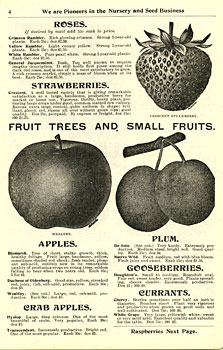
1903 Will Seed Compnay Catalog Page 4
SHSND# 10190A few club members remembered vegetables that rarely show up in other records of historic gardens. Mabel Price grew celery in a moist spot at the bottom of a hill in Oliver County. The celery was a cash crop. (Courtin’, p. 87) Another grew dry (shell) beans which dried in the garden and were harvested late in the fall for winter bean dishes. This is probably not an unusual crop, but seldom mentioned. (Sods, p. 130)
Fannie Mahood Heath, was an pioneer gardener who became known internationally for her gardening, especially with the native plants of ND. While her passion was for flowers and trees, she also identified, cultivated, traded, and sold native fruit shrubs of North Dakota. As Diede indicated, pioneers were well aware of these fruits, as were Native American gardeners before them. Heath promoted the use of chokecherries, Juneberries, buffaloberries, wild grapes, high-bush cranberries, plums, and crabapples, in a shelterbelt to provide food for birds and people. Inside the shelter belt was a good, sheltered place for a vegetable garden which included rhubarb, asparagus, strawberries, raspberries, currants, and gooseberries. The garden should be placed to get morning sun and afternoon shade, especially if the garden is dependent on rainfall for moisture. She illustrated her manuscript with hand drawn and colored pictures of flowers and fruit shrubs. These include plum, sunflower (Helianthus sp.), and Juneberry.




